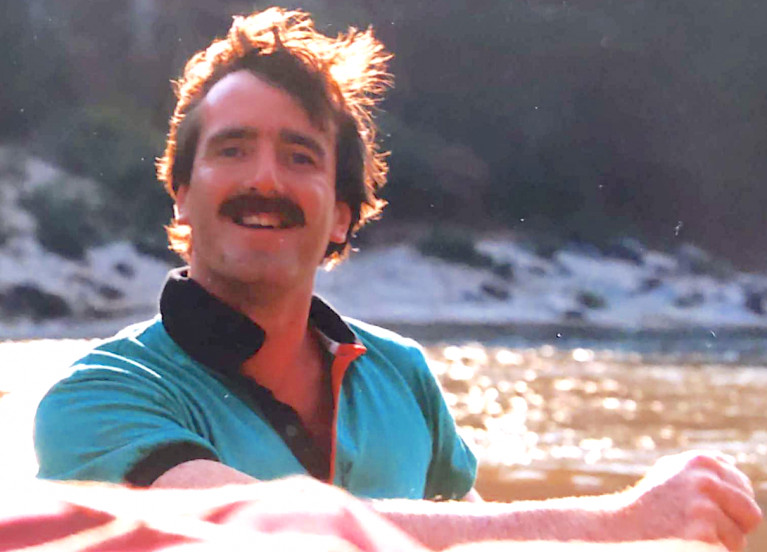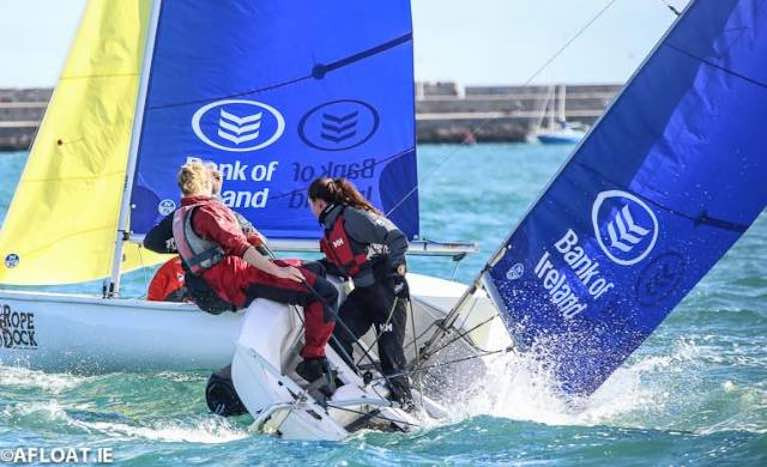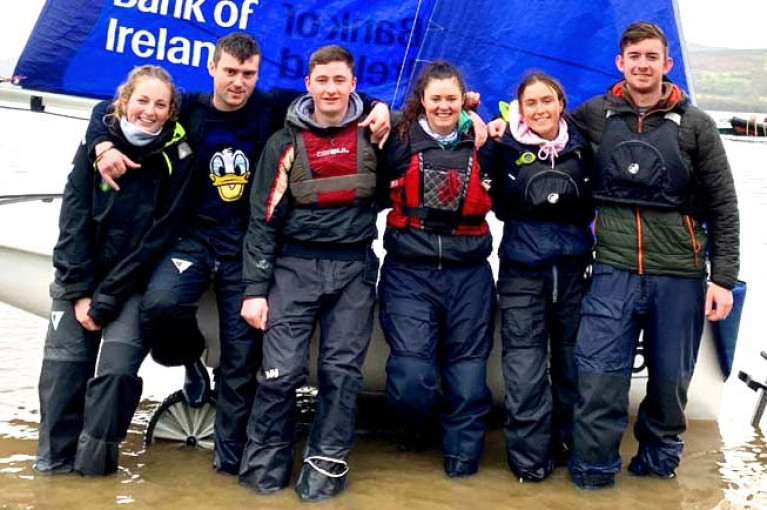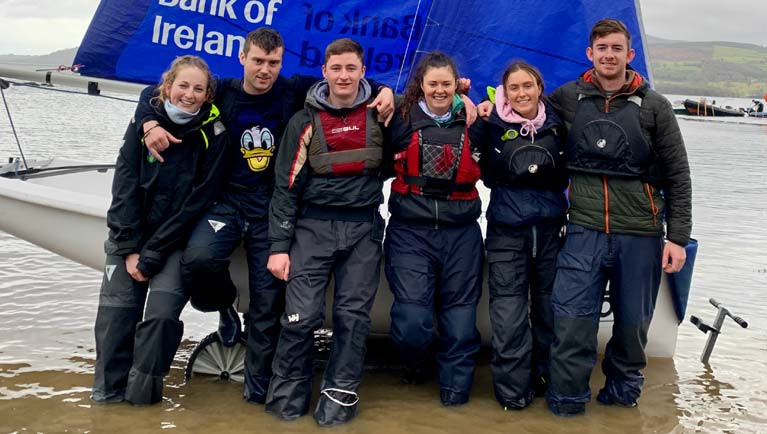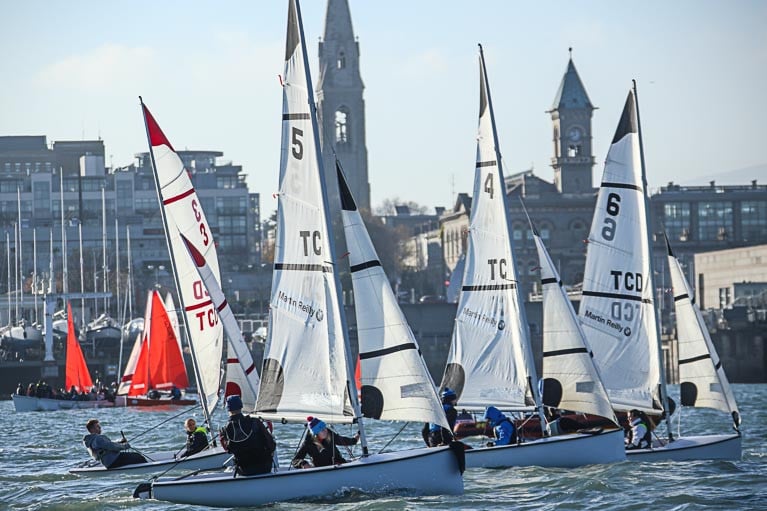Displaying items by tag: Team Racing
More than 40 teams of young sailors are set for battle this weekend as the 2021 Eric Twiname Team Racing Championships returns.
Around 240 junior and youth sailors from across the country will descend on Oxford’s Farmoor Reservoir to compete for the top spot over two days of team-on-team action.
It will be a welcome return for the much-loved event, which had to be cancelled in 2020 due to the pandemic.
Racing will take place in Firefly dinghies for youth teams and RS Fevas for juniors, with prizes awarded in each category.
Teams are made up of three boats in the youth fleet and two boats for juniors, each crewed by two sailors. Teams compete in a round-robin before the top teams face off in a knockout to determine the winners.
To promote gender equality in sailing, mixed-gender teams were given priority during the entry process. As a result, of the 47 teams competing only five are single-gender with a significant increase in the proportion of female helms competing from previous years.
Niall McLeod, RYA Racing Services Manager, said: “The Eric Twiname Team Racing Championships is a real highlight of the racing calendar, and we’re delighted to see it return in 2021.
“Team racing is a really exciting, fun and sociable discipline of sailing combining tactics and teamwork, and it’s great for improving fleet racing skills such as boat handling and rules knowledge too.
“We are pleased to see so many mixed-gender teams at this year’s event, and we’re looking forward to a real showcase of team racing this weekend.”
The regatta, named after famous sailor, author and journalist Eric Twiname, has seen many members of the current British Sailing Team compete in previous editions such as 470 sailors Eilidh McIntyre, Amy Seabright and Georgina Povall.
Entries are subsidised by the Eric Twiname Trust, which was set up in Twiname’s name following his death in 1980.
Results will be posted here
After a staggering 137 races sailed over the weekend and a stirring comeback on the Sunday morning, RStGYC Sea Buoys won the sixth Elmo team racing trophy with a convincing 2-0 victory in the final.
Gentle breezes were the order of the day on Sunday, with teams trying to put wins on the board to make the finals. Three rounds of racing saw each team complete 15 races before a final between the top two teams from the host club, Sea Buoys and 29ers.
The competition was close across the fleets, with The National Yacht Club first team winning the Silver league unbeaten. The 'Leftovers' made up of a mixed clubs team, proved they should not have been left behind by taking the Bronze Fleet.
The event in its sixth year continues to attract a mix of boy/girl teams across clubs and classes. The firefly dinghy allows crews to quickly get up to speed with roll tacks and gybes as they manoeuvre around the starboard S course. Races typically last 6-7 minutes, but this is more than enough time for plenty of tactics, fast sailing and teamwork.
For next years seventh edition, organisers RSGYC are aiming for 5 flights of firefly dinghies and 30 teams! 180 youth team racers would be epic!
 Team Bullship at the Elmo Trophy dinner
Team Bullship at the Elmo Trophy dinner
Overall: 1st Sea Bouys, 2nd 29ers, 3rd Bullship.
Silver Fleet: NYC1
Bronze Fleet: 'LeftOvers'
Royal Cork Team Racers Lead Elmo Trophy After 72 Races Sailed at Dun Laoghaire Harbour
The 108 team racers came ashore on Saturday after champagne sailing conditions saw the Royal Cork team emerge unbeaten after Day one of the Elmo Trophy at the Royal St. George Yacht Club.
Race officer Conal Casey and his team completed Round 1, and are now halfway through the Gold Silver Bronze round.
Teams enjoyed the event dinner where more sunshine ensured the outdoor seating wasn't a washout!
The home club, RSGYC features prominently with many teams in the Gold league and will be hoping to knock RCYC off their perch.
18 Teams Ready for 130 Races at RStGYC's Sixth Elmo Trophy
The full lineup of 18 teams will be ready to battle in Dun Laoghaire Harbour this weekend for the sixth Elmo Trophy.
This youth sailing team racing event will see teams of six sailors representing their clubs or classes race in the 18 Firefly dinghies that are supplied for the event.
The 108 competing sailors at the Royal St George Yacht Club are aged between 13 and 19 with a 50:50 split between boys and girls.
The team travelling the furthest is a first-time entry from Glandore Yacht Club skippered by Conor Cresswell, while one of the host teams will include a member of Liverpool's West Kirby Sailing Club.
On paper, very strong lineups are entered from Royal Cork skippered by Lola Kohl, National Yacht Club skippered by Natasha Hemeryck, the 29er class skippered by Trevor Bolger and the Waszp class skippered by Max Goodbody.
A host team skippered by Finn Walker will look to defend the trophy won last time by 'Curious George' in 2019.
Over 130 races are expected to be sailed with the final scheduled for Sunday afternoon.
The Royal Saint George Yacht Club welcomes youth team racers from around the country for its Elmo Trophy competition on August 28th and 29th in Dun Laoghaire Harbour on Dublin Bay.
The event will be sailed in three flights of Firefly dinghies, where teams of six crews will race each other in a round-robin format.
Download the Notice of Race below
Teams must consist of six members from the same club, school or dinghy association. At least two members must be aged 16 and under on 31st December 2021. All team members must be aged 19 or under on 31st December 2021 and still attending second level education in 2021 (i.e. the event is not aimed at University Students).
The home team will hope to defend the trophy won by 'Curious George' in 2019 when 130 races were sailed over the weekend.
This year will see some new entrants such as Glandore Harbour Yacht Club, who have been training in a fleet of Fireflies already this season.
 The Royal St. George's Elmo Trophy
The Royal St. George's Elmo Trophy
The unique format of the event looks to split teams into pools of equal standards to ensure close racing for all while allowing every pool to have a chance to qualify for the quarter-finals.
To be placed on the entry list, email John Sheehy – [email protected]
Download the Notice of Race below as PDF document
Jimmy Fitzpatrick 1957-2021
One of Dublin Bay's great sailing characters Jimmy Fitzpatrick of the Royal Irish Yacht Club has sadly passed away.
A true corinthian of sailing Jimmy Fitz was very well known both here and abroad. While he sailed out of the Royal Irish, he could be spotted most seasons holding court on the balconies of all the waterfront clubs. He was on first-name terms with everyone. All who met or sailed with Jimmy would agree that a friendlier, considerate or more entertaining companion was hard to find. He had a deep raucous laugh that was not easily missed.
In honour of Jimmy's life, the flags of each of the Royal Irish Yacht Club, the Royal St. George Yacht Club and the National Yacht Club were flown at half-mast on the day of his funeral last Thursday, January 28.
Like many, he was bitten by the bug when introduced to sailing at the age of seven by his brother Richard. Jimmy later became a head instructor with the Royal Irish and the Royal St George and also instructed in the National Yacht Club alongside current Dublin Bay Sailing Club Commodore Ann Kirwan.
He attended the 50th-anniversary dinner of the N.Y.C. junior section organised by Carmel Winkelmann, where many stories of regattas in Mount Shannon and Rosslare were regaled. Jimmy was very much the Rodney Marsh of sailing, moments of brilliance on the water while partying hard onshore. He knew what it was like to cross the line first in a Dragon Gold Cup race. Win a Wednesday night Wag race. In the Fireball Nationals in Sligo in the early 80s, he beat Adrian and Maeve Bell to a race gun.
 Jimmy Fitzpatrick at the helm of his Fireball on Dublin Bay (with Michael Blaney on the wire) in the 1980s
Jimmy Fitzpatrick at the helm of his Fireball on Dublin Bay (with Michael Blaney on the wire) in the 1980s
At the time the Bells were in the top three in the world, on crossing the line Jimmy jumped overboard to celebrate and later that night the husband and wife duo magnanimously presented Jimmy and crew Mick Blaney with a bottle of Champagne. Years later, Jimmy and Mick nearly divorced when Jimmy simultaneously put the mast through the floor of the boat and his dad's garage roof in a late post regatta parking manoeuvre. Jimmy co-skippered alongside Mark Mansfield, a boat sponsored by his employers AIB in the 1988 Round Ireland Race. In 2004, Jimmy's nephew Rory represented Ireland at the Olympics in Greece. Jimmy worked hard behind the scenes to help Rory gather funds for the campaign to get him qualified.
It was when Jimmy got to UCD that his real passion in sailing developed; it was Team Racing. Jimmy competed in hundreds of team racing events over the years. He won the colours match for U.C.D. three years in a row setting the platform for the Rhinos (Spike, Joe Blaney & Marto Byrne) to go win it for another three years after that. In the '80s Jimmy moved to London and his flat became a focal point for not only Irish team racers but all the UK teams. He guest-helmed for the Nottingham Outlaws at the Illingworth trophy organised by HMRN. At the time the Outlaws were one of the top teams in the UK He set up his own team of sailors based in London and called them the Wild Geese. It was never clear what the criteria for qualification were but an ability to party was essential. Jimmy even managed to get a few West Kirby sailors to sail with the Wild Geese when short on numbers.
While competing at the Wilson Trophy one year, West Kirby had decided to try something different and hired a top sports commentator from Radio Liverpool to do some commentary on the team racing on the lake. They even installed a stand beside the caravan where the commentator was based. After a few hours, not even one man and his dog was watching or listening to what was unfolding and to make matters worse, the poor commentator knew nothing about sailing. Toll Smith a grandee of WKSC saddled up to Jimmy who was holding court in the wet bar and asked if he would mind spending a few minutes with the commentator to give him a few pointers on the sport. After a short conversation, the commentator from Liverpool Radio suggested to Jimmy he has a go at commentating on the next race. He passed the microphone to Jimmy and as they say the rest is history. Four hours later, Jimmy emerged from the caravan to a standing ovation from a full stand and a big crowd all around the lake. Jimmy later went on to commentate on the team racing worlds held in the Royal St.George, on the Sydney Olympics with RTE and was also invited to commentate with Sky Sports on a fledging International 14ft circuit.
Team racing appealed to Jimmy because he loved the camaraderie and people loved being in his company. He was very involved in the hearings on whether Commercial Cruise Ships should be allowed enter Dun Laoghaire Harbour. In the last decade, Jimmy struggled with his mental health, and many in the sailing community did their best to help him through difficult times.
 Jimmy Fitzpatrick (third from right) sailing on Mick Blaney's (standing) 31.7 in the 2019 Volvo Dun Laoghaire Regatta Photo: Afloat
Jimmy Fitzpatrick (third from right) sailing on Mick Blaney's (standing) 31.7 in the 2019 Volvo Dun Laoghaire Regatta Photo: Afloat
Jimmy still managed to compete with Mick Blaney on his Beneteau 31.7 right up till racing was cancelled last July. Despite the pressures, he was going through his ability to spot a wind shift never left him. Jimmy would have been the first to point out that when we sail, we always take precautions for our own safety and that of our crew. So onshore let's not forget to take care of our mental safety and that of our friends.
 Jimmy Fitzpatrick in his role as race officer for the Water Wags on Lough Boderg
Jimmy Fitzpatrick in his role as race officer for the Water Wags on Lough Boderg
Team racing and Dublin Bay will be the poorer for the loss of the unbridled enthusiasm of Jimmy Fitz. He only had one speed, and that was full-on.
Fair winds my friend.
DS
More photo memories of Jimmy have been provided by his friends and family here
Royal St George Yacht Club Cancels Elmo Trophy Team Racing Event at Dun Laoghaire Harbour
The 2020 Elmo trophy for team racing at Dun Laoghaire Harbour has been cancelled. With the current measures in place to halt the spread of the coronavirus event organisers RStGYC have made the difficult decision to cancel the event for 2020.
Unlike conventional fleet racing regattas, the Elmo Trophy sees groups of young sailors sharing Firefly dinghies, carrying out on-water changeovers using support RIBs and often being in close proximity to one another ashore.
It also requires a high number of support staff and volunteers, as well as attracting a large number of spectators to the club.
A postponement to October and a change in format to 2v2 Team racing was considered to enable the event to be sailed but with the recent rise in cases, the event has now had to be cancelled.
This year's event was to have seen the addition of the new ISA fleet of fireflies and the introduction of a Swiss league to ensure teams on similar standards continued to race against each other all weekend. Both of these would have helped build on last year's record entry of 22 teams and 4 flights of boats.
RStGYC looks forward to welcoming teams back in 2021.
It may seem like another world now, but the energetically-organised Irish Inter-varsities team racers managed to get in their 2020 Championship early in March before the Covid-19 clampdown closed in. The venue was University of Limerick’s watersports facility at Killaloe on Lough Derg, and in three decidedly hectic days of Firefly racing, University College Dublin Firsts emerged as overall winners. Their Sailing Captain is Daniel Raymond, so he gets the nod as our Team Racer of the Month, but it’s all about team effort, and the complete lineup was Jack Higgins, Daniel Raymond and Patrick Cahill as helms, while crews were Alanna Lyttle, Kathy Kelly and Lucy McCutcheon, with Lucy McCutcheon (winner in 2019) taking the Irish Universities Sailing Association “Crew of the Year” title
UCD Sailing Club Win 2020 Team Racing Intervarsities
UCD Sailing Club has won the Irish University Sailing Association (IUSA) Team Racing Intervarsities 2020.
They came out on top after three tough days racing at UL Adventure Centre, Killaloe. Following three extremely competitive finals, UCD Sailing managed to take home not only Platinum Fleet (UCD 1) but also Gold (UCD 3) & Silver Fleet (UCD 5).
The UCD 1st's consisted of the helms Jack Higgins, Sailing Captain Daniel Raymond, Patrick Cahill and crews Alanna Lyttle, Kathy Kelly and Lucy McCutcheon. Lucy was also awarded IUSA crew of the year!
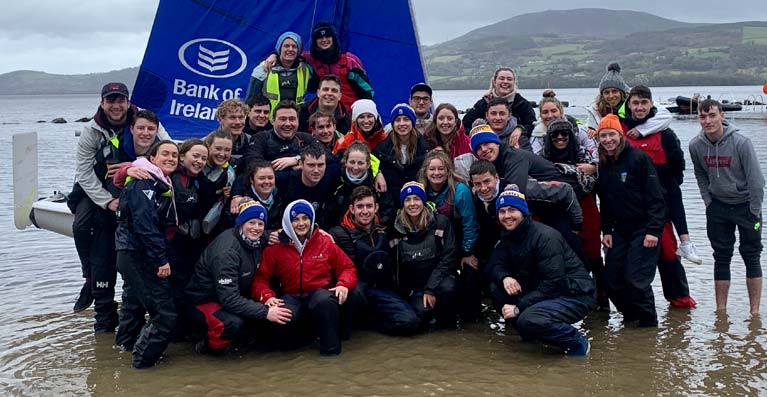 Intervarsity sailors at UL in Killaloe on Lough Derg
Intervarsity sailors at UL in Killaloe on Lough Derg
UCD Sailing has now qualified for BUSA Team Racing National Championships in England for the second year in a row.
Niamh Doran the Commodore, Shaun Condon the varsities captain and UCDSC’s committee organised the fantastic few days with top quality racing and were pleased to see the turnout of over 250 competitors.
The next event is UCD Vs Trinity Colours match and will be held in the 4th of April. They would like to thank their sponsors Bank of Ireland.
Irish Sailing Team Racing Weekend Scheduled for Howth
Howth Yacht Club will welcome the Irish Sailing team racing roadshow funded by BIM - Bord Iascaigh Mhara - (Ireland's Seafood Development Agency) which is designed to attract sailors between the ages of 14 – 30 from around the area, it is not just for members of HYC.
The Roadshow will start at 10 am on Saturday 7th March and run for two days. Team Racing is a fun and inexpensive way for clubs to attract young dinghy sailors after they have left the structured environs of class youth racing or the Irish Sailing Training Schemes. All boats and instructors will be there on the day, all sailors have to do is turn up in their winter sailing gear. Given the time of year, we would advise that sailors have sufficient dinghy sailing competency to cope with reasonable winds and colder climes. With a focus on rules knowledge, boat handling, tactics and team building, the programme will further develop transferable skills and give rise to skilled and competitive racing in a very sociable environment. Participants have the option of doing both days or just one day if they prefer and the cost is €30 for one day or €50 for both. See the event flyer here for more details.
This initiative came from active Howth Yacht Club member, Darragh O'Connor who teaches in Sutton Park School and is heavily involved in sailing himself. Darragh first started team racing in Schull community college which he says hugely benefited him in his college sailing days and he was hooked, not only by the competitive but fun racing but also by the great social side attached to the events. This event is the first of what is hoped to be many new sailing initiatives which will be run by Howth Yacht Club this season, all with the aim of making sailing in the club more accessible to all ages and levels.
For more information regarding the event please contact Christina Knowles [email protected] or to book your space you can phone the office in HYC at 01-8322141.


























